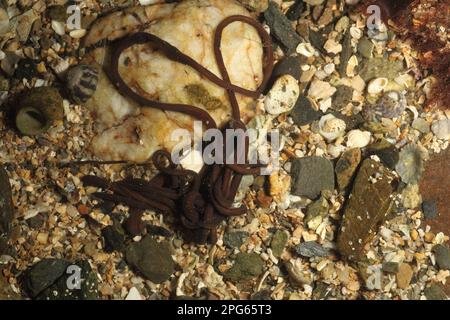
Bootlace worms are a type of *lineus*, and they’re known for their peculiar behavior, especially during the low tide. Just like how we can’t help but explore the tide pools when the water recedes, these worms come out to play, or rather, to hunt and gather food. As we dive deeper into their world, we’ll explore what makes bootlace worms so unique, how they behave in low tide, and why they’re an important part of the marine ecosystem.
What Are Bootlace Worms?
Bootlace worms belong to a group called *Nemertea*, commonly known as ribbon worms. They can be incredibly long—some reaching up to 30 meters! Imagine a piece of spaghetti that’s been stretched out to its limits; that’s the kind of flexibility we’re talking about. Their bodies are segmented and soft, which helps them squeeze into tight spaces.
These worms typically have a complex body structure that includes a proboscis—a special feeding appendage. When hunting, they can shoot this proboscis out to capture prey like small fish or crustaceans. You might not see one in action often, but when you do, it’s like watching nature’s own version of a magician pulling a rabbit out of a hat!
Low Tide: A Unique Opportunity
During low tide, the ocean recedes, leaving behind a whole new world to explore. This is the perfect time for bootlace worms to venture out of their usual hiding spots in the sand. When the tide is low, they can hunt more actively without the threat of being submerged.
It’s like a buffet opening for them. They get access to all sorts of food that would normally be out of reach. They’ll often be found in the muddy substrate, wriggling around as they search for their next meal. It’s fascinating to think about how, while we’re enjoying the beach, these worms are busy foraging.
The Feeding Habits of Bootlace Worms
Now, let’s talk about what bootlace worms eat. They primarily feed on *small invertebrates*—think tiny shrimp, amphipods, and even the occasional fish larva. Their proboscis isn’t just for show; it’s armed with **hollow stylets** that can inject toxins into their prey, making it easier to capture them.
Their feeding strategy is quite effective. When they find something tasty, they can stretch out to wrap around it, almost like a hug! Once they have a grip, they pull it in and feast. This hunting method showcases their amazing adaptability and dexterity, which is crucial for survival in a competitive marine environment.
Why Low Tide Behavior Matters
Understanding bootlace worms and their low tide behavior is more than just an interesting fact; it plays a significant role in marine ecosystems. These worms are vital for nutrient cycling and serve as food for various predators, including fish and birds. By feeding on smaller invertebrates, they help maintain balance in the ecosystem.
Additionally, their burrowing habits can help aerate the sediment, promoting a healthy environment for other marine life. So, next time you see a bootlace worm at low tide, remember—it’s not just a squirming mass of flesh; it’s a key player in the ocean’s delicate balance.
How to Spot Bootlace Worms
If you’re keen to observe these creatures up close, there are a few tips you can follow. Look for them in sandy or muddy areas when the tide is low. They tend to hide beneath rocks or within the sand, so you might need to get your hands dirty.
Here’s a simple way to find them:
- Go during low tide.
- Search along the shoreline in sandy or muddy spots.
- Use a small trowel or your hands to gently sift through the sand.
- Look for long, wiggly shapes—this might be your bootlace worm!
Just remember to be gentle. These creatures are delicate and should be returned to their habitat as soon as you’re done observing them.
Comparing Bootlace Worms to Other Marine Creatures
You might be wondering how bootlace worms stack up against other marine creatures. Let’s take a look at two fascinating comparisons: *sea slugs* and *earthworms*.
– **Sea Slugs**: Like bootlace worms, sea slugs have vibrant colors and soft bodies. They primarily feed on algae and can often be seen in tide pools during low tide. However, unlike bootlace worms, sea slugs can be quite easy to spot due to their bright hues.
– **Earthworms**: While earthworms live in soil, they share the same important role of aerating their environment, similar to the burrowing habits of bootlace worms. However, earthworms don’t have the same hunting strategy or proboscis—so their feeding methods differ greatly.
Each of these creatures plays a unique role in its ecosystem, showcasing the diversity of life on our planet.
Conservation and the Future of Bootlace Worms
Sadly, many marine creatures, including bootlace worms, face threats from habitat loss, climate change, and pollution. Understanding their role in the ecosystem can help us advocate for their protection. By promoting clean beaches and healthy oceans, we can ensure that these fascinating worms and other marine life continue to thrive.
Conservation efforts don’t have to be overwhelming. Here are a few simple actions you can take:
- Participate in beach clean-ups.
- Educate others about marine life and its importance.
- Reduce plastic use to lessen ocean pollution.
Every small step counts in preserving the delicate balance of our oceans and the unique creatures that inhabit them.
In conclusion, bootlace worms are more than just an unusual sight at low tide. They’re fascinating creatures with unique behaviors that contribute significantly to marine ecosystems. The next time you’re exploring the shoreline during low tide, keep an eye out for these remarkable worms and appreciate the role they play in our oceans. After all, every little creature, no matter how small or wriggly, has a place in the grand tapestry of life.
